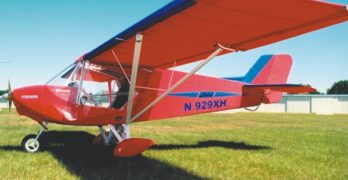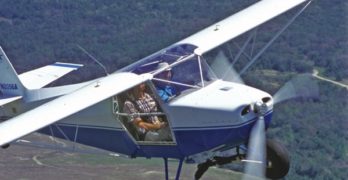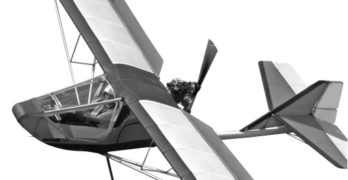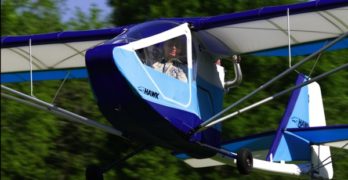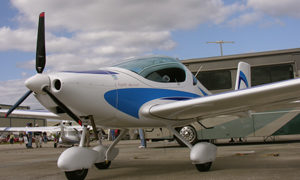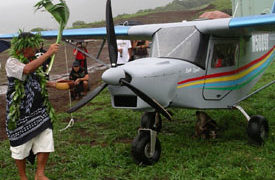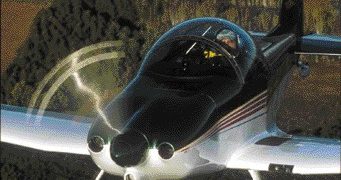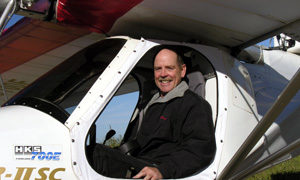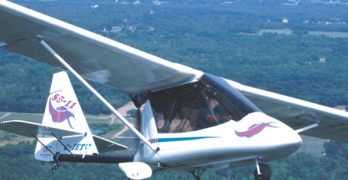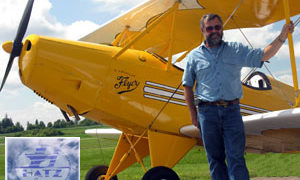UPDATE 2008: The following article preceded the arrival of the X-Air LS offered by X-Air LSA, certified in 2008 as a Special Light-Sport Aircraft under ASTM standards. The article below appears unchanged from the original, but the airframe is essentially identical. So, while panel changes were made along with a few minor updates, flying qualities reported in the following article should largely match that of the new LSA version.
It was Tax Day, April 15, and I prepared to fly an Xair H (N#929XH) owned by importer Bill Magrini of Light Wing Aircraft. It seemed an appropriate day to forget about what I owed the Internal Revenue Service and to enjoy some ultralight flying. Fortunately, the Xair H didn’t disappoint.
The Xair H isn’t the designer or fabricator’s name for the new plane. When I first saw the then-prototype design at a French airshow in ’02, the new model was named Hanuman, which means little to American pilots.
Search Results for : evolution
Not finding exactly what you expected? Try our advanced search option.
Select a manufacturer to go straight to all our content about that manufacturer.
Select an aircraft model to go straight to all our content about that model.
Just Aircraft’s Highlander
If you’re familiar with Avid Flyer or Kitfox aircraft, you know at least something about Just Aircraft’s Highlander. Its pedigree “path” is somewhat meandering but leads to an excellent flying machine born of a rich American airplane design heritage.
Dean Wilson was the originator of this now-proven design shape. The first departure from Wilson’s Avid Aircraft company was Dan Denney, who went on to offer the Kitfox. Denney’s prowess as a marketer brought international fame to the Kitfox and, over the years, the sale of nearly 3,000 aircraft. At one time Denney Aerocraft was among the country’s largest suppliers of kit-built aircraft. What had been an ultralight design evolved into a successful 2-seat homebuilt, but that wasn’t the end of the evolution behind Wilson’s original creation. Denney sold his company to Phil Reid, who renamed the Idaho company SkyStar.
A Well-Evolved History
Another break-off from Avid Aircraft and Denney Aerocraft was Flying K Enterprises, which introduced the single-seat Sky Raider.
CGS Aviation Makes Hawk
Remember why we fly ultralights? Few general aviation airplanes are flown below 1,500 feet above the ground. More rare is flight at 500 feet or 50 feet. Neither do you tend to fly most light-sport aircraft (LSAs) at these denser altitudes. Most flights in general aviation or LSA planes start out climbing high as quickly as possible. You switch on the autopilot as soon as possible and fiddle with the throttle, prop and mixture controls to squeeze all the fuel economy you can while flying as fast as the machine will manage in the straightest possible line all the way to your destination.
That’s fine for general aviation or LSA flying, and it’s enjoyable in a different way. But it isn’t ultralight flying.
What about just “boating around” the sky at your leisure, turning every few minutes to see the sights only possible from an ultralight aircraft. Your eye catches an alligator off to one side and you bank quickly to check it out.
CGS Pulls Out the Stops
… to keep the Hawk Ultra Light
Genuine ultralights still
have a place. These
aircraft|excuse me,
ultralight vehicles,
the least-FAA-regulated
flying machines,
will not be sent to aircraft boneyards
despite what some light-sport aircraft
skeptics may think. The Hawk Ultra
is proof positive CGS Aviation loves
ultralights and wants you to have fun
in the air.
No matter the pros and cons of
the sport pilot/light-sport aircraft (SP/
LSA) rule, operating a Part 103 ultralight
remains simpler than earning a
sport pilot certificate and buying an
LSA. No certificate, no medical, and
no registration is needed (though, it is
recommended that folks register with
one of the three associations supporting
ultralights-EAA, the United States
Ultralight Association (USUA), and Aero
Sports Connection (ASC). Additionally,
an ultralight can be fully factory built
without FAA inspections. The list of 103
privileges goes on, and the Hawk Ultra
qualifies for all of them.
One-Oh-Three Interest Soars
I don’t know about the “build it
and they will come” premise when
it comes to baseball fields, but I fervently
believe that if enough customers
want a product, someone will supply
it.
A Mystique, Yes; But Not a Mystery
LSA America is a newly formed company separate from but associated with Fantasy Air USA, importer of the very successful Allegro*. The new company displayed their Mystique from Flying Machines, which won SLSA #46 just before the Sebring LSA Expo. This lovely bird has smooth flowing lines all the way to a squared off vertical stabilizer. I took a test flight in Mystique to find a light handling airplane with huge visibility. Built in the Czech Republic, Mystique joins Interplane’s Skyboy in LSA America’s lineup. Mystique has a contemporary appearance and equipment neatly fitting the LSA mold and looks second generation compared to the low-cost Skyboy. Look for my report in EAA Sport Pilot soon (perhaps the March or April 2007 issue). On less than 26 feet of span, Mystique boasts a 15:1 glide; such performance is hard to judge in an hour flight but clearly Mystique held energy well.
How Shall We Count New SLSA?
Barely over a month ago, I reported that Skykits Corp won their first approval for the Savannah. In that SPLOG posting I said that the plane would be produced with three wings mated to the same fuselage. Now, proving the point, Skykits president Eric Giles announced his second SLSA approval…for a Savannah ADV. Eric also claimed the airplane delivered to Hawaii was the first SLSA to be registered in the state (photo). *** Savannah ADV has a tapered airfoil with full-span retractable leading edge slats and double-slotted flaps, both operated electrically with a mechanical backup. Skykits says, “The new wing increases cruise speed by 25 mph while maintaining the STOL capabilities. “As their company name implies, kits are also available. The questions arise, though: Is this a new model or a model variation? Do we count it as a new SLSA? We’re bound to have more such questions as the LSA evolution continues.
World’s Fastest Mustang II?
When most of us think about a fast airplane, we sketch in our minds a sleek and smooth exterior and wings that allow the graceful machine to slip through the air with the least possible resistance. We think the engine is also important and that more power is better than less.
But according to race winner Brian Schmidtbauer, up to 30% of the total drag in an aircraft can be cooling drag, or air movement through the engine compartment.
Because I often review gliders and slower powered aircraft, I’m sure I displayed a slack-jawed response to this comment. The stunned expression stayed on my face as Schmidtbauer described detail after detail about the handling of cooling air.
After an hour-long flight in his blazing Mustang II, I came away a believer. His homebuilt aircraft has beaten the likes of jet-smooth Lancairs and isn’t threatened by speedy RVs. In fact, only his buddy and RV-4 pilot Dave Anders has beaten Schmidtbauer in a race, and they’re so close that the next race might be different.
Back in the Saddle in a Flightstar Ultralight
On a glorious fall day over the undulating hills of northeast Connecticut, I returned to flight after a five-month hiatus. Encouraged and accompanied by my old friend Tom Peghiny we enjoyed an hour sightseeing flight over the verdant countryside surrounding Tom’s Flightstar Sportplanes enterprise at the Woodstock airport. Gosh, it felt great to get back in the air! *** With the first revolution of the wheels I noticed how light the Flightstar seemed. I’ve done most of my flying in Light-Sport Aircraft lately and I guess I’d forgotten just how light ultralights can feel. We left the ground in a couple hundred feet lifted by a HKS 700E four stroke distributed by HPower. In an age of $100,000 LSA, this $25,000 Flightstar IISC certainly seems affordable to plenty of Americans. At 400 pounds less than LSA at gross, turns were pleasant low-gee maneuvers.
Eye On the Sky Watch
There was a time when a company called Beaver RX Enterprises – which produced the Canadian Beaver designs – was among the leading North American ultralight manufacturers.
In particular, the Beaver 550 tandem 2-seater attracted many customers. The company once claimed more than 3,500 ultralights flying. Certainly the model dominated the western Canadian market but also had a presence in the U.S. and other countries.
The old Beaver RX Enterprises company went through a number of leadership changes and, driven by overly-ambitious management goals, finally succumbed.
When I visited the now defunct company, the firm was a publicly-held corporation listed on the Vancouver Stock Exchange. Even the stock exchange has experienced a transformation, so perhaps it isn’t surprising that Beaver RX Enterprises also lost its heading.
As we’ve seen with other good designs, however – such as Quicksilvers, Phantoms or Drifters – the better ultralights can outlast their ownership. The Beaver line is among those survivors.
Gorgeous, Award-Winning Biplane from Duluth
EAA’s Minneapolis Sport Pilot Tour, plagued at first with some logistical challenges, came off very well. More than 500 LSA-interested attendees showed up at Airlake airport south of the Twin Cities metro. The local Sport Pilot school, LSA North at the Aircraft Resource Center, exhibited their CTs along with the Sportstar, KP-5, RANS S-6 and S-7 and others. One of the charmers was the award-winnng Hatz Bantam from builder Mark Marino. The Bantam is an evolution of the original John Hatz biplane designed in the 1960s. Leap forward in time and the lighter Hatz can be flown by a Sport Pilot. Previously only plans were available but Marino is now working on Hatz Partz, components that represents elements of a full kit. The 1,320 pound Bantam is powered by a 120-hp Jabiru 3300 six cylinder four stroke. It can carry a couple two hundred pounders and fly 110 mph.
- « Previous Page
- 1
- …
- 15
- 16
- 17
- 18
- 19
- …
- 21
- Next Page »


